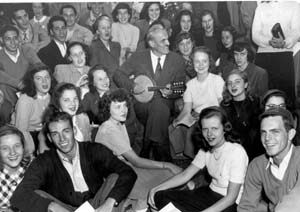
Arthur Holly Compton (with banjo) spent three years at the University in the early 1920s before becoming dean of physical sciences at the University of Chicago for more than 20 years. But in 1945, Compton returned to Washington University as chancellor. In his eight years as chancellor, he pulled the University out of the depths of The Depression and set it along a path toward greatness. In 1927, he shared the Nobel Prize in physics with C.T.R. Wilson. His first major discovery was the detailed measurement and interpretation of the wavelength change occurring when X-rays are scattered, especially by materials of low atomic number. This is now generally known as the Compton Effect. He showed that the loosely bound electrons in the material scatter the X-rays in accordance with the principles of conservation of momentum and energy, as if they consist of a stream of photons, each having momentum as well as energy. The energy aspect goes back to Planck and Einstein; but the Compton Effect afforded the first clear demonstration that the X-ray photons also carry quantified amounts of momentum. Throughout World War II, Compton also played an important part in the general planning of the atomic bomb project, include the setting up of the laboratory at Los Alamos, N.M., and in reaching the military-political decisions about the use of the bombs in Japan.